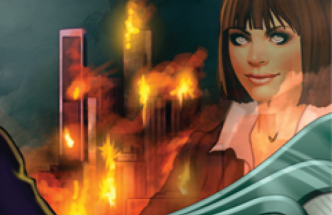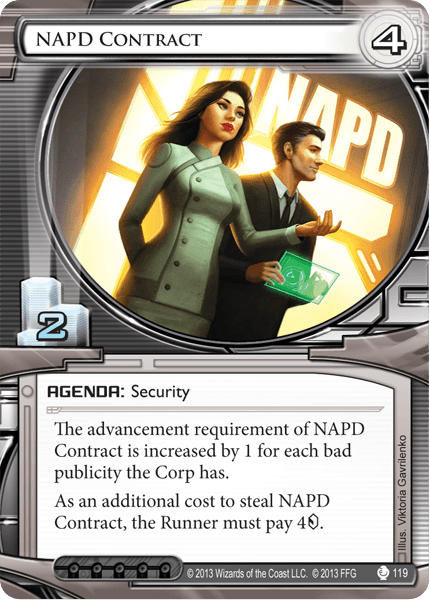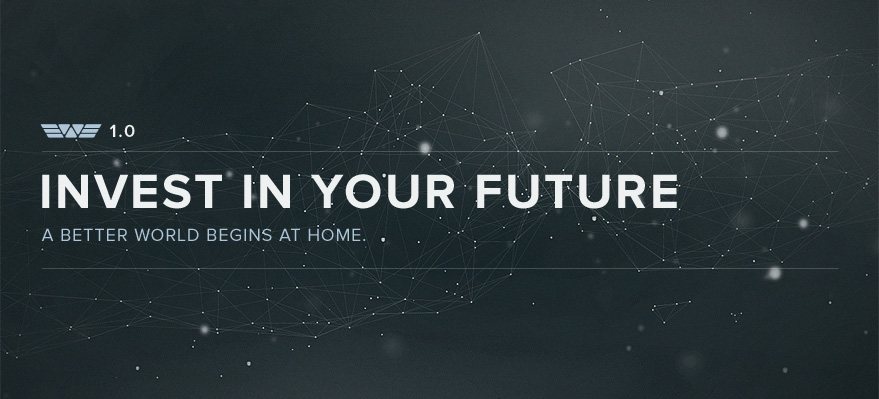Ever since I read David Sutcliffe’s take on Martin Presley’s “Supermodernism” archetype, it’s been my thing. I’ve always had a particular affinity for Weyland: the utility agendas, the back breaking ice, and the worst case ability to find the enemy, kill the enemy, and burn his playground…all of it. The specific play style Supermonderism encourages fits me like a glove, however, which is why I chose it as half of the package (opposite a standard fare Rocket Knight build) that helped me stay undefeated in the Swiss portion at the Chicago Regionals the other week (9th overall, Gabe bricked on me in double elim).

While I am eternally grateful to the Satellite Uplink for bringing the archetype to a wider audience, there are a few points, as well as some larger mumblings, that I disagree with. Take, for example, the idea that skilled player will be able to recognize what a Supermodern player is attempting to do and be able to mess with tempo to counter the thing. Or the whispers in various forums and groups that Supermodernism as an archetype is dead, or severely falling behind. Heck, I had someone flat say that to me (not in jest) in Chicago. Now, as then, I beg very much to differ.
I should preface this by saying I understand the reasoning for such a criticism. It’s very easy to look at the build as a pseudo-fast advance stack, and extrapolate an exploitable weakness to losing tempo, a hallmark weakness of many Fast Advance decks. That being said, such a reasoning is wrong. Yes, we play stuff and score from hand. Yes, we force the runner to present early game pressure or risk getting outpaced. Yes, tags are a factor for us. And yes, losing tempo can cost us the game. However, Supermodernism is not a FA deck. It’s an aggressive deck, and there is a difference.
For a lot of you, that may seem obvious, but it deserves being said even if it should go without saying. We just need to get that out of the way so we can really dig deeper. The real power of the build, and clarity about how to play it well, can be distilled further then this and requires somewhat of a paradigm shift in your thinking about the Corp side game as a whole.
Think about the last time you explained Netrunner to an uninitiated friend. You probably gave an explanation that included a narrative of one hacker player trying to bypass the obstacles the other Corp player has set up in an effort to find certain, point-scoring cards, and you wouldn’t be wrong. That is what you will see when you watch people play Netrunner. Think about when YOU play Netrunner, however. You’re not thinking “I’m going to get in there and find an agenda”, you’re thinking about the specific choices you’re about to make to do that, all the various math and potential moves and counter moves.
There are two aspects to that statement that are key. First, at it’s heart, Netrunner is a game about making choices. Furthermore, consider the asymmetry and realize that at the outset the Corp holds all the cards so to speak, and that the first three choices the Corp player makes will not only set the initial pace for the game, but also largely directly dictate what choices the runner will make. Tempo is the Corp’s to lose. Therein lies the crux of the power of Supermodernism. It is a deck that realized the entire game is, at it’s most basic level, about choices, and it does it’s very best to ensure every single one the runner has to make is terrible.
And with that, lets view an example:
“Because We Hate You And Want You To Know It”
GRNDL: POWER UNLEASHED
Total Cards: (49)
Agenda: (12)
False Lead (A Study in Static) x2
Geothermal Fracking (Opening Moves) x3
Hostile Takeover (Core) x3
Project Atlas (What Lies Ahead) x3
The Cleaners (Second Thoughts) x1
Asset: (4)
GRNDL Refinery (Fear And Loathing) x1
Snare! (Core) x2 ••••
Jackson Howard (Opening Moves) x1 •
Project Junebug (core) x1 •
ICE: (16)
Chimera (Cyber Exodus) x2
Archer (Core) x3
Enigma (Core) x3
Guard (Honor and Profit) x2
Ice Wall (Core) x2
Grim (Opening Moves) x2
Bastion (Creation and Control) x2
Operation: (17)
Anonymous Tip (Core) x2 ••
Hedge Fund (Core) x3
Restructure (Second Thoughts) x3
Scorched Earth (Core) x3
SEA Source (Core) x1 ••
Punitive Counterstrike (True Colors) x2
Subliminal Messaging (Fear and Loathing) x2
ID Choice:
While there are 3 Weyland IDs to chose from, until we get Blue Sun, you really are only looking at 2 options: GRNDL or Building A Better World. Because We Built It is cute (a concept we’ll discuss in depth in later posts), but it doesn’t really fit with what you’re trying to do in a Supermodernism build. BABW is a decent choice because Supermodernism leans on events for it’s economy, and the extra credit can add up fast, which can help smooth out hiccups in your cash flow. 5 extra influence can accomplish a lot, too. Conversely, GRNDL starts with large cash advantage and builds from there. Sure, you start with a bad pub, but it’s a calculated risk, and not nearly as big a deal as it is elsewhere.
If I had to boil it down to a quick oversimplification, I’d say that BABW requires closer management of your economy (especially early game, where Account Siphons are more of a concern) while opening you a slightly wider set of tools you can consider including. GRNDL is more forgiving on the bank account but demands a more decisive and careful approach in it’s line of play.
Agenda Choice:
While pretty much every agenda in the game does stuff, one can argue very effectively that, overall, the Weyland set brings the most utility to the table. Certainly the most variety. Your choices should reflect your play style and support your overall approach. Some, however, are arguably stronger in this shell. Most builds will start with 3 each of Project Atlas, Hostile Takeover, and Geothermal Fracking. Being able to over advance Atlas for tutoring is a no brainer, and the cash influx you gain from Geothermal and Hostile Takeover can be quite convenient, even with the Bad Publicity.
I included False Lead because the ability to cut a runner’s turn in half can be a serious advantage, and most runners forget it’s even there. This slot could just as easily be a Veteran’s Program if you just can’t stomach the bad publicity, or if you’re the kind of player who will forget it’s there too. Additionally, any of them gives you something small to chuck to Archer in case Hostile Takeover hasn’t shown up. Profiteering is a choice but I’d keep HT in either way. The ability to score, make that bank, and threaten an Archer, all from hand, is just too valuable. And just because you don’t mind bad pub doesn’t mean you should go handing out out like candy.
I chose to include The Cleaners in the 3 point slot because of not only the extra potential meat damage (always a fear with Weyland), but because it adds a level of uncertainty to the board and makes the runner that much more unsure about what direction you might be going. In most builds, Archer is the only thing that would make Priority Req worth it, so it’s not often seen. Government Contracts is another popular choice, although I find the economy it provides is overkill. You could run Executive Retreat, sure, but why? What does it do for you, other then making your opponent feel bad about themselves having to look at super ripped dudes hanging out in a tub? Seriously though, you don’t want to have to risk having to chose between holding stuff in hand and scoring an agenda unless you have a good reason.
Despite it being the new hotness, I’d avoid trying to find a way to fit NAPD contracts in there. As we’ve mentioned, even outside of GRNDL, bad pub is a thing, and it’s not at all uncommon to accrue enough BP to make the 4 credit tax a non-issue for the runner in addition to penalizing you. It would be more of a consideration in a build that used Veteran’s Program, but I still wouldn’t do it.

You might be tempted to include Posted Bounty or Vulcan Coverup, but that indicates more of a lean on Scorched kills. Don’t. Scorched Earth is a back-up, alternate win condition that you shouldn’t be shy about using if the opportunity presents itself, but you should never force it. Understand it’s pretty much a non-starter once Plascrete hits.
ICE Selection:
When choosing ICE, you are looking for 3 things: affordable, analog, and, when possible, nasty. It’s not difficult to see where most of my ICE choices fall within those categories, and while these are, for the most part the tried and true “default” set, there is no “right” set. They just tend to be the most common, and for good reason. Ice Wall is cheap and can get bigger if you need. Bastion, Enigma, and Chimera all have decent stopping power, especially early game. Guard helps not only mix up the type variety, but stave off some of the pressure from run events that bypass ICE. Grim and Archer are what makes the runner bleed, and, properly timed, can turn the rest of the game into one wide open scoring window, especially since the runner will be tempted to run fast, early, and likely with only a partial rig.
That being said, I feel that while some ICE is definitively better then others in this shell, Archer is really the only auto-include, and the rest leaves a lot of room to play. Guard used to be Wall of Static, and could easily be again. One might experiment, for example, with finding room for a Fenris over a Grim, depending on if you feel like the hit to strength and drain on influence is worth the extra end the run subroutine (I don’t). Maybe you really want to drive your hatred home and splash nasties like Swordsman, Wall of Thorns, Komainu, or Rototurret. There is a lot of flexibility, and a lot of ability to accommodate your personal style and still be effective. Just bear in mind you want less taxing ice, and more definitive ETR ice.
Utility:
While you have to be mindful of things like economy, assets and events too offer a lot of flexibility and room to express yourself. Once you make sure your cash flow is set, go nuts. SEA/Scorch is a powerful combo and has won countless players countless games and is very heavily recommended in any Supermodernism build as a backup kill. It’s a hallmark, and more so, forces the runner into a very predictable line of play until they can get a Plascrete or two on the table. It’s not uncommon for players, usually ones who have eaten a turn 3 Sea-Scorch-Scorch in the past, just not to run on Weyland until they’re suited up or fresh off of Quality Time, leaving you free reign to build board state and clinch tempo.
Snare is something almost every Supermodern build includes, usually to hold in hand or sometimes bluff as a Jackson, but I have to be honest. I’m not really that impressed with it’s performance, and there are better things I can do with that 2 influence. Take Project Junebug, for example. A lot of people I’ve played tend to forget that card exists when they sit down against Weyland, and it has done more work then Snare ever has, even winning me a few games on it’s own. I also enjoy how the synergy with the rest of my selections. Someone who, for example, has seen me power through and cash out a massive GRNDL Refinery or an over advanced Project Atlas is more likely to run at an advanced Junebug. The reverse is true as well. Someone who has seen or faceplanted a Project Junebug is going to be a lot more hesitant to run something with a counter or two on it. If you wanted to really buck the trends,you could strip them out entirely and trade in Aggressive Secretary. Corporate Troubleshooter is murder in this deck, especially when Archer shows up, but there is rarely any surprise when you flip him, since that’s probably not a Caprice and definitely not a San San. He’s weaker here then elsewhere.
On the topic of Jackson, while I admit he is a powerhouse, I do not care about him in my build at all. Heresy, I know. If I were playing Power Shutdowns, I might hold him in slightly higher esteem, but in this build, he’s a chump. He’s there to distract the runner and make them waste clicks and credits trashing him (and lets be honest, they will). Sure, it’s nice to be able to recur from archives and draw 2 for 1, but that functionality is just icing on this cake, and Supermodernism can get along fine without him. Even in decks that run Power Shutdown, you won’t see him as often as you would think.

Personally, I don’t really like Power Shutdown, which is why I traded it out for Punitive Counterstrikes. People expect Shutdowns, and they are not that hard to play around. Compounded with what you risk getting dumped into archives, I decided it wasn’t for me. I prefer penalty over prevention (with risk!) and while I’d rather not see the runner score something, 3 credits to make the runner spend 5 or take what is likely 2 meat damage isn’t a bad deal.
And GRNDL Refinery is amazing and has saved my bacon a bunch of times. Trust me, try it. Between the boatload of cash you stand to make (44 credits is my record), and the aforementioned level of uncertainty it adds, I can’t recommend it enough.
Bringing It Together:
Now I know I’ve spoken a lot about versatility and choice, but there is such a thing as too much of a good thing. After a certain number of changes, you’ve changed it into something else. So let’s come full circle: go back and read the title of my deck. It’s not just clever smarm, but the play philosophy behind the deck as well. You want the runner to know that whatever they do, it’s either going to hurt, or put them at substantial risk. If they know their choices are bad and worse, so much the better. They might just chose to do nothing, which is always in your favor.
But what you should be doing is two prong and simple: 1) Build an economy, throw down an ice or two, and start powering out agendas. Or what they think are agendas. Don’t be reckless with your agenda play, but don’t be timid. Be fearless. Calculated, but fearless. 2) Keep your line of play proactive. You want the runner reacting to you, and not the other way around. There will be some give and take, and the occasional nut hand blowout or flood is inevitable, but for the most part you should gain and maintain control of tempo from turn 1 or 2, and you can do this with something as simple as choice in ice play.
For example, leaving an open HQ is an invitation, and an okay one to send in certain circumstances, since you know it will most likely dictate a run, even if it’s just for information. Anything the runner sees from you or your cards is information, and that can (and should, if you play correctly) work in your favor. Sure, let them into your hand. When they see you’re holding a Scorched Earth or a Sea Source, or they pull a Snare, they’re going to be a lot less likely to pay you another visit soon. Account Siphon is always a problem, but most runners are going to be hesitant to take the tags against Weyland, since Beanstalk-Scorch is a real concern when you can reasonably assume both are 3-ofs in BABW, and it’s a non-issue for GRNDL unless you drew no first turn econ and the runner is chaining 2 of them.
Take advantage of the fact that runners like to face check these days and try to anticipate their line of play. When you see a Shaper ID, it’s a fair bet that within the first few turns they will be tutoring up a Magnum Opus and making some runs, probably with a Corroder or a Clone Chip, maybe a SMC. Feel free to have a Grim waiting for them and take out that MO. Feel free to tempt them with a False Lead or something to make sure it happens. Attrition is a thing, and it is entirely acceptable to give a little ground if it means gaining a long term advantage. Play the race, and do what you can to cost the runner time. Again, be calculated, but fearless. A single misstep from the runner is all it takes to give you the opportunity to take the game.

You obviously can’t read your opponent’s mind, but at the end of the day, a lot of players, especially good ones, are very formulaic good with their practiced lines of play and “technically correct”. Knowing this, it is not too hard to anticipate what an opponent is most likely to do given a certain scenario. Use that to your advantage, create those scenarios, and catch the runner off guard. Create the choice of bad, worse, or nothing. Tailor the bad choices to your play style. Throw in your “signature ice”. Try going horizontal and rock the ambushes, a play style I intend to experiment with once Shattered Remains drops (I needed new shorts after that one spoiled). Just keep the runner guessing, keep them afraid.
Final Thoughts:
This deck, and more to the point, the shell, is an adaptable and powerful machine (the build above is currently 16-0 IRL/Online) that burns with the fury of a 1000 (blue) suns, but with that power comes danger and the need to maintain control. Supermodernism is deck that punishes mistakes, and that doesn’t just go for the runner. There are a lot of “correct” lines of play the deck presents you. Some times it’s letting the runner burn themselves out walking into Grims, Archers, and ambushes. Sometimes you drop a chimera, over advance an Atlas or Two, and spend the next three turns scoring fetched Hostile Takeovers from hand for the win. Some times you Sea-Scorch-Scorch inside the time it takes the Stairway to Heaven intro to finish. But you had better be able to recognize which is the one you’re going to take and maintain control while you’re doing it (which isn’t as hard as it sounds).
Supermodernism is the Mean Headmaster of Corp decks. It doesn’t coddle you or reward correct play with Simba moments and gingers from heaven, Supermodernism simply expects it, and will let you know the moment you deviate from course, yet quietly smile the more vicious you are. Just as a single miss-play can mean the end for the runner, a mistake on your part can cost you your proactive posture, cost you control of YOUR choices. The moment your choices become reactionary is the moment you start to lose.
Even if it doesn’t end up being for you, Supermodernism is a deck I recommend everyone try at least a dozen times. It’s not for everyone, but the insight that it gives you into not only your choices and style as a player, but the underlying cadence of the game as a whole, is worth the time spent shuffling it up, and has a very real chance of creating teachable game moments and helping you improve as a player.
Be careful, though, the power might just go to your head.







